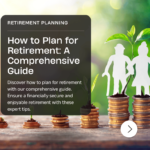How to Save for Retirement in Your 30s
Meta Description: Discover effective strategies on how to save for retirement in your 30s. Secure your future with expert tips and financial planning.
Introduction
Saving for retirement in your 30s is a crucial step toward securing a comfortable and financially stable future. Many people overlook the importance of early retirement planning, often underestimating the benefits that come with starting to save at a young age. This article delves into various strategies and tips to help you save effectively for retirement during your 30s, ensuring you make the most of this pivotal decade in your financial journey.
Understanding the Importance of Early Retirement Planning
One of the most significant advantages of starting your retirement savings in your 30s is the power of compounding interest. The earlier you begin, the more time your money has to grow, leading to a larger nest egg by the time you retire. Early planning also allows you to take more calculated risks with your investments, potentially yielding higher returns.
Benefits of Starting Early
Starting early means you can contribute smaller amounts over a longer period, reducing the strain on your current finances. Additionally, you have more time to recover from any market downturns, which are inevitable over long investment horizons. Early savers often benefit from employer-sponsored retirement plans, tax advantages, and the ability to set more aggressive savings goals.
Assessing Your Current Financial Situation
Before diving into retirement savings, it’s essential to understand your current financial position. Assess your income, expenses, debts, and existing savings. This comprehensive view will help you determine how much you can realistically set aside for retirement without compromising your present financial stability.
Calculating Retirement Needs
Determine how much you’ll need to retire comfortably. This calculation should consider factors like expected living expenses, inflation, healthcare costs, and any additional income sources like Social Security. Online retirement calculators can provide a rough estimate, but consulting with a financial advisor can offer a more tailored plan.
Setting Clear Financial Goals
Establishing clear, achievable financial goals is vital for any retirement plan. Break down your long-term retirement goal into smaller, manageable milestones. For instance, aim to save a certain percentage of your income each year or strive to reach specific savings benchmarks by the end of each decade.
Developing a Retirement Savings Plan
Creating a robust retirement savings plan involves selecting the right savings vehicles and investment strategies. Consider a mix of employer-sponsored plans, individual retirement accounts (IRAs), and other investment options. Ensure your plan is flexible enough to adjust to life changes and market fluctuations.
Maximizing Employer-Sponsored Retirement Plans
Many employers offer retirement plans like 401(k)s, often with matching contributions. Take full advantage of these programs by contributing at least enough to receive the maximum match. This is essentially free money that can significantly boost your retirement savings.
401(k) and Its Advantages
A 401(k) plan allows you to save pre-tax dollars, reducing your taxable income and growing your retirement funds tax-deferred. Many plans offer various investment options, enabling you to diversify your portfolio according to your risk tolerance and retirement goals.
Roth IRAs and Traditional IRAs
IRAs are excellent tools for retirement savings. A Traditional IRA offers tax-deductible contributions and tax-deferred growth, while a Roth IRA provides tax-free withdrawals in retirement. Depending on your income level and retirement strategy, you might choose one or both types of accounts.
Diversifying Your Investment Portfolio
Diversification is key to managing risk in your retirement portfolio. By spreading your investments across different asset classes like stocks, bonds, and mutual funds, you can mitigate the impact of market volatility and enhance potential returns.
Balancing Risk and Reward
In your 30s, you have a longer time horizon before retirement, allowing for a higher risk tolerance. This means you can invest more heavily in equities, which historically offer higher returns. As you age, gradually shift toward more conservative investments to preserve your capital.
Exploring Stocks, Bonds, and Mutual Funds
Stocks provide the potential for high growth but come with greater risk. Bonds offer more stability and regular interest payments, making them a good counterbalance to stocks. Mutual funds and exchange-traded funds (ETFs) allow for diversified exposure to various assets, simplifying the investment process.
Automating Your Savings
Set up automatic transfers from your checking account to your retirement accounts. Automation ensures you consistently contribute to your savings without having to think about it, reducing the temptation to spend the money elsewhere.
The Power of Compounding
Compounding interest is a powerful force in growing your retirement savings. By reinvesting your earnings, you can generate returns on both your initial investment and the accumulated returns from previous periods, exponentially increasing your savings over time.
Minimizing Debt and Managing Expenses
Reducing high-interest debt is crucial for freeing up more money for retirement savings. Focus on paying off credit card balances, student loans, and other high-interest debts. Simultaneously, adopt a frugal lifestyle to keep your living expenses low and maximize your savings potential.
Debt Repayment Strategies
Employ strategies like the snowball or avalanche methods to systematically reduce your debt. The snowball method involves paying off the smallest debts first, gaining momentum as each balance is eliminated. The avalanche method prioritizes debts with the highest interest rates, saving you more money in the long run.
Budgeting for Savings
Create a detailed budget that allocates a specific percentage of your income toward retirement savings. Track your spending to identify areas where you can cut back and reallocate those funds to your retirement accounts.
Seeking Professional Financial Advice
A financial advisor can provide personalized guidance based on your unique financial situation and retirement goals. They can help you develop a comprehensive retirement plan, select appropriate investments, and adjust your strategy as needed.
Choosing the Right Financial Advisor
Look for a certified financial planner (CFP) with a fiduciary duty to act in your best interest. Check their credentials, experience, and client reviews. A good advisor will take the time to understand your goals and tailor their advice accordingly.
Staying Informed About Financial Markets
Stay updated on market trends and economic news. Understanding how various factors affect your investments will help you make informed decisions and adjust your strategy as needed.
Adjusting Your Plan as Life Changes
Life events like marriage, children, career changes, and health issues can significantly impact your retirement plan. Regularly review and adjust your plan to accommodate these changes and ensure you stay on track toward your retirement goals.
The Role of Inflation in Retirement Planning
Inflation erodes the purchasing power of your savings over time. Factor in an average inflation rate of 2-3% when calculating your retirement needs. Investing in assets that typically outpace inflation, like stocks and real estate, can help protect your savings.
Tax-Advantaged Accounts and Their Benefits
Utilize tax-advantaged accounts like 401(k)s, IRAs, and Health Savings Accounts (HSAs). These accounts offer tax benefits that can significantly enhance your retirement savings. HSAs, for example, provide triple tax advantages: tax-deductible contributions, tax-free growth, and tax-free withdrawals for medical expenses.
Maintaining Financial Discipline
Financial discipline is crucial for long-term success. Stick to your savings plan, avoid impulsive spending, and resist the temptation to withdraw from your retirement accounts prematurely.
Common Pitfalls to Avoid
Avoid common mistakes such as underestimating retirement expenses, relying too heavily on Social Security, and failing to diversify your investments. Additionally, avoid taking on unnecessary debt and tapping into your retirement savings early.
How to Save for Retirement in Your 30s
Saving for retirement in your 30s is both a challenge and an opportunity. By starting early, you can take advantage of compounding interest and tax benefits, ensuring a secure and comfortable retirement. Prioritize your savings, seek professional advice, and remain disciplined in your approach.
Frequently Asked Questions
How much should I save for retirement in my 30s? Aim to save at least 15-20% of your income. This percentage can be adjusted based on your specific retirement goals and financial situation.
What are the best retirement accounts for someone in their 30s? 401(k)s, Roth IRAs, and Traditional IRAs are excellent choices. Consider HSAs if eligible, as they offer additional tax advantages.
How can I maximize my employer’s 401(k) match? Contribute at least enough to receive the full employer match. This is free money that can significantly boost your retirement savings.
Should I pay off debt or save for retirement? It’s essential to balance both. Prioritize high-interest debt while contributing to retirement savings. A financial advisor can help create a plan that addresses both goals.
How does inflation affect my retirement savings? Inflation reduces the purchasing power of your money over time. Invest in assets that typically outpace inflation to protect your savings.
Can I retire early if I start saving in my 30s? Yes, starting early increases your chances of retiring early. With disciplined saving and smart investing, you can build a substantial nest egg.
Conclusion
Saving for retirement in your 30s is a proactive step toward financial security. By understanding the importance of early planning, setting clear goals, and leveraging various savings strategies, you can build a robust retirement fund. Stay informed, seek professional advice, and remain disciplined to ensure a comfortable and financially stable future.


